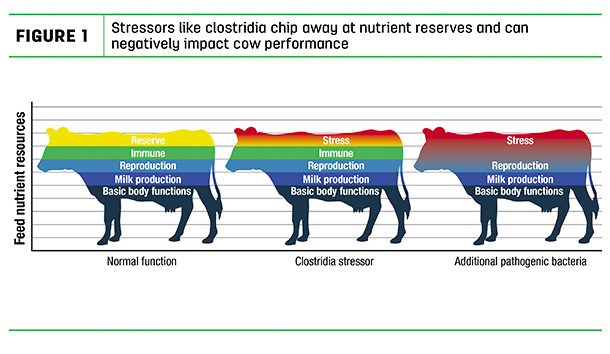One good example of this phenomenon is hemorrhagic bowel syndrome (HBS), a deadly disease often linked to clostridial challenges in feed and most frequently reported in high-producing cows. Even if “dirty” feed is fed to less susceptible groups or slowly fed out using the age-old practice of “dilution is the solution to pollution,” it may still result in lackluster performance and impact income over feed cost (IOFC). Once we have purchased or grown and ensiled a feed, ensuring it gets to the cows as clean as possible is key.
Clostridia: The invisible challenge
When thinking about feed hygiene, clostridia are an important bacterial group to consider because they can have a wide range of negative effects on cows. A comprehensive, nationwide sampling project in 2017 identified hundreds of different strains of clostridia in feed and fecal samplings. Not only were these strains of clostridia diverse, but they varied by region. A recent resampling carried out between 2020 and 2021 reconfirmed the diversity of clostridia across the country and showed that the regional populations had shifted over time.
Because of the diverse nature of clostridia, it can be associated with many different issues in cattle. As mentioned previously, one of the most common diseases is HBS, which has been linked to proliferation of C. perfringens in the lower GI tract. Other species of clostridia, such as C. beijerinckii and C. bifermentans, aren’t associated with clinical disease but do ferment valuable feedstuffs into alcohols instead of volatile fatty acids (VFAs). Many of these alcohols are antibacterial and can limit the growth of rumen bacteria. In some ways, these types of bacteria can be more damaging to a dairy because their effects are subclinical (not presenting in clinical disease) and silently drag down production or increase variability in the herd.
A good way to illustrate the impact of bacterial challenges is to think of cows as having a nutrient-use hierarchy (Figure 1).
Feed nutrients will first be used to support basic functions of life, followed by things like milk production, growth, reproduction, etc. Any extra nutrients form a reserve for the cow to draw on in stressful times. When bacterial stressors, like clostridia, are present in the feed, they slowly chip away at the nutrient reserve until, eventually, they impact things we can see, like reproduction and milk yield. In many ways, this is equivalent to subclinical stressors such as overcrowding – there may be no visible sign of stress; the cow is just more susceptible to the next stressor breaking through.
Minimize clostridia through management
Many bacteria, including clostridia, are often soil-borne, so implementing practices to keep soil out of the feed is key. Fortunately, there are many small steps that can be taken throughout a crop’s life cycle to reduce soil contamination:
- Manage how and when to apply brown water irrigation relative to harvest, through actual harvest practices such as cutter bar heights and the speed at which to drive the chopper or mower.
- During ensiling, feeds should be stored on clean pads with proper drainage so potentially contaminated runoff is directed away from the feed.
- When delivering that feed, be sure to avoid driving over the feed table with mud- and manure-laden tires, just to incorporate it into the feed with the next round of push-ups.
- In addition to keeping feed dirt- and manure-free, cleaning up old TMR, whether in the mixer or on the feed table, is valuable because data shows clostridia can grow in the TMR.
While many of these issues may seem trivial, they can quickly add up to increase the bacterial burden on the cow and chip away at her reserves. All on-farm decisions should be made looking through the hygiene lens to minimize contamination risks; otherwise, any improvements we expect to see in rumen function or energy efficiency could be overshadowed by bacterial challenges.
Bolster management with targeted probiotics
Across both sampling projects referenced earlier, 98.8% of cows sampled tested positive for clostridia. This highlights that even with the best feed management practices in place, clostridia will still find their way into feed and into cows. Clostridial loads in a TMR are often between 50 and 500 cells per gram. This may not seem like a lot, especially when compared to bacterial counts on probiotics with hundreds of millions of cells per gram. But when you multiply it out (100 cells per gram x 100 pounds AF intake x 454 grams per pound), you get an intake of 4.5 million cells of clostridia every day – a substantial number. Clostridia populations within a bunker can vary significantly, with hot spots of contamination spread throughout the bunk, leading to individual bites of TMR delivering much higher or lower loads of clostridia. This cow-to-cow and day-to-day variation in clostridial challenge can lead to differences in cow production, intake and fecal consistency.
Because cows consume some level of clostridia on a daily basis, probiotic products targeting clostridia are a great option to layer on top of feed hygiene-focused management decisions. The diverse nature of clostridia makes it vital to choose a bacterial probiotic that shows targeted or even regionally specific clostridial control. In addition to targeting clostridia, probiotics support rumen function and immune health, both of which impact nutrient absorption and efficiency. While no probiotic will completely eliminate clostridia from the system, they can help reduce the average level a cow faces and support the nutrient hierarchy. In this way, nutritionists and producers can decrease the likelihood that eating a bad slug of silage will push any cow over the edge.
The fact that clostridium is dosed to cows daily means controlling it daily, whether through a probiotic product or active monitoring of management, is key. ![]()
-
Clayton Stoffel
- Technical Services Manager
- Papillon
- Email Clayton Stoffel









